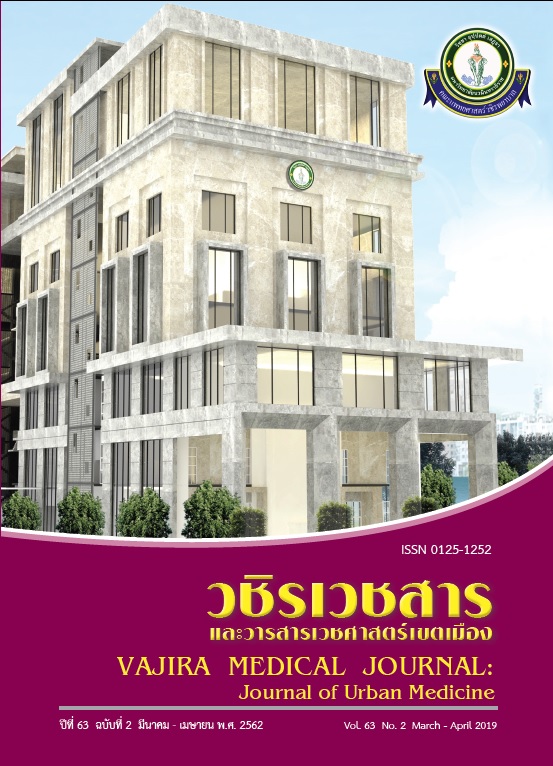Stakeholders’ perception on performance outcomes of student development program based on Thai qualifications framework for higher education at Boromarajonani College of Nursing, Sanpasitthiprasong: A comparative study between academic year 2015 and 2016.
Main Article Content
Abstract
Objectives: To compare outcomes of student development program according to thai qualifications framework for higher education following stakeholders’ opinion in academic year 2015 and 2016 at Boromarajonani College of Nursing, Sanpasitthiprasong.
Methods: This analytical research compares outcomes of student development program according to thai qualifications framework for higher education following stakeholders’ opinion in academic year 2015 and 2016 at Boromarajonani College of Nursing, Sanpasitthiprasong. About 46 of stakeholders in academic year 2015 and 85 in academic year 2016 were purposively selected to participate in the study. Data were collected between June to July 2017 in year 2015; year 2016, between June to July 2018. The questionnaire comprised participants’ background performance of graduated students based on thai qualifications framework for higher education and opened end questions. The Cronbach’s alpha was .92. Descriptive statistic, pair t-test for mean comparison, was used to analyze quantitative data and content analysis was used to analyze qualitative data.
Results: The study showed that: The majority of the stakeholders graduated bachelor degree or equivalence (92.9% in 2015 and 87.0% in 2016) and about 7.1% (year 2015) and 13.0% (year 2016) graduated master degree. The mean score of the performance of the graduated students in academic year 2015 was on a good level (=4.20, SD=.30). The highest score was on ethics and moral domain (
= 4.46, SD=.38), the second score was in knowledge domain (
=4.40, SD=.41) and the lowest score was on cognitive skills domain (
=4.01, SD=.44). The mean score of the performance of the graduated students in academic year 2016 was on a good level (
=4.42, SD=.29). The highest score was on ethics and moral domain (
=4.75, SD=.30). The second score was on interpersonal skills and responsibility domain (
=4.68, SD=.33) and the lowest score was on knowledge and cognitive skill domain (
=4.24, SD =.43). Most of Stakeholders focus on nursing instructors training nursing students about nursing research and nursing innovation.
Conclusion: The findings of this study can be used for planning a curriculum at Boromarajonani Collage of Nursing, Sanpasitthiprasong to provide learning activities for nursing students to be able to develop six nursing performances and to achieve goals and course learning outcomes for a quality graduation and standard nursing
Downloads
Article Details
References
2. Praboromarajchanok Institute of Heath Workforce Development. Strategy and action plan of Praboromarajchanok Institute of Heath Workforce Development. Bangkok: Rumthai Press CO; 2011. p.194-226.
3. Boromarajonani College of Nursing Sanpasithiprasong. Performance report: Quality of graduates and the 21st century assessment project (Fiscal year 2017). Ubonratchathani: Academic Department; 2017.
4. Srisatidnarakul B. The methodology in nursing research. 5th ed. Bangkok: You and I Intermedia Partnership; 2010. p. 231-40.
5. Prommapun B. Techniques for data interpreting for mean comparison in research. STOU Educational Journal, 2015; 8(2): p. 24-40.
6. Sawangdee Y. Content analysis. The Institute for Population and Social Research, Mahidol University. Available from: www. spu.ac.th/research/files/pdf. Retrieved October 11, 2018.
7. Sirasoonthorn P. Start up your research project. Available from: http://www.socsci.nu.ac.th/th/wp-content/uploads/2015/09/ParadigmAndSystems Thinking.pdf. Retrieved October 12, 2018.
8. Thumsoue S, Yingrangreang S, Ratchawat P. The evaluation of graduate quality according to Thai qualifications frameworkfor higher education in academic year 2010-2011 at Boromarajonani College of Nursing Saraburi. Journal of Health Science Research, 2013; 7(2): p. 10-7.
9. Apichutboonchock S. Evaluation of Nutrition Project for Nutrition Education Enhancement among Baccalaureate Nursing Students in Boromarajonani College, Sanpasithiprasong. Vajira Medical Journal, 2015; 59(1): p. 47-57.
10. Yotongyos M, Sawatdisan P. Determination of sample size for research [Internet]. Nakhon Ratchasima: Suranari Hospital;2014 [cited 2018 Oct 13]. Available from: http:// HYPERLINK “http://www.fsh.mi.th/km/wp-content/uploads/2014/04/resch.pdf” www.fsh.mi.th/km/wp-content/uploads/2014/04/resch.pdf.
11. Nursing Division. Guidelines for the development of nursing service plan. Pathumthani: Suetawan Publisher; 2018. p.10-6.
12. Siwaromaya K. Motivation factors of Master’s Degree Students to pursue a study at Nakhon Ratchasima College. Create and develop to the ASEAN community 2nd National conferences and research presentations; 2015 June 18-19; Muang, Thailand. Nakhon Ratchasima college; 2015: p. 449-59.
13. Apichutboonchock S. Student nurses’ experiences of individually nursing care and holistic care in pediatric intensive care unit of students in third year of Baccalaureate Nursing Program. Vajira Medical Journal, 2014; 58(3): p. 33-41.


